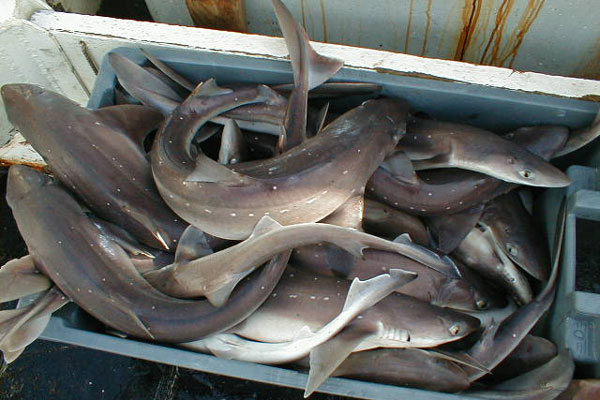SEA SCIENCE: 2010 Fishery Resource Grants: Ushering Benefits, Rewards for Coastal Communities, Ecosystems

This article was published in the Summer 2010 issue of Coastwatch.
If you’re a regular reader of Coastwatch magazine, you’ll know that one of the mainstay efforts of North Carolina Sea Grant is managing the N.C. Fishery Resource Grant Program.
You’ve probably seen those three little letters — “FRG” — in many of our feature articles. From experimenting with saltwater pearl culture in Wilmington (Spring 2010) to inspiring community supported fisheries projects along the Atlantic coast (Winter 2010), from tracking sea turtle migrations (Early Summer 2004) to developing value-added seafood products (Autumn 2002), FRG-funded projects have sparked research and innovations benefiting all who enjoy or earn a living from North Carolina’s precious coastal resources.
The FRG program has been funded by the North Carolina General Assembly since its creation in the mid-1990s, and it has been administered by North Carolina Sea Grant for almost as long. Although funded at $1 million annually for most of its history, the program has received several cuts over the past few years, with its state support reduced to $854,000 in 2008, and then further reduced to $600,000 in 2009. For the 2010-2011 budget year, the FRG program has been slated in various state budget proposals for cuts ranging from half to all of its state dollars.
Yet the research continues. For any given year, North Carolina Sea Grant might receive FRG proposals from commercial fishermen who want to try bycatch-reducing gear, or a research team investigating the health of Pamlico Sound oysters, or fish growers exploring new species for aquaculture production.
For the 2010 round of FRG awards, the selection committee picked a variety of proposals for funding. Stay tuned to the exciting initiatives outlined below — you could be reading more about one as you flip through a future edition of Coastwatch magazine.
Efficient Water Oxygenation and Purification of Aquaculture
• Keith Bolick, Bob King and George Moore, Clean Water Scientific
Despite their oxygen-producing benefits, algae can be quite a nuisance in commercial aquaculture farms. Industry researchers at Clean Water Scientific in Raleigh will work with partners at N.C. Department of Agriculture and Consumer Services, North Carolina State University Biology Department and Castle Hayne Fisheries in Aurora to test the use of ozone as a way to control algal blooms.
Pilot Commercial-Scale Testing of Promising Diets for Intensive Cultivation of Southern Flounder and Black Sea Bass in N.C. Using an Alternative Protein Source
• Ted Davis, Aqua Plantations
• Keith Hairr, Carolina Flounder
• Shawn Longfellow, Blue Ocean Farms
• Wade Watanabe and Md. Shah Alam, University of North Carolina at Wilmington
Don’t let the long title confuse you, because these researchers have a simple question: if you want to farm carnivorous fish like sea bass and flounder, can you feed them diets made from soybean and poultry? Feed made with fishmeal is costly and still relies on dwindling wild fish harvests — one of the original arguments for promoting aquaculture. Finding an equally efficient alternative could help fish growers.
Development of a Holding System for the Sale of Live Black Sea Bass
• Tom Burgess, commercial fisherman in Sneads Ferry
• Tom Losordo, North Carolina State University
Wild black sea bass also is an important North Carolina fishery. But fishermen sometimes struggle to make a profit. Wholesale deliveries of live fish to niche markets in the Northeast could be one solution to increase profit per pound. Losordo and Burgess will experiment with warehouse tanks that will hold live wild sea bass for potential customers between capture and transport.
A GIS Assessment of NCDMF Oyster Enhancement from 1981 to 2009
• Eugene Ballance, commercial fisherman in Ocracoke
The N.C. Division of Marine Fisheries has planted shell and rock material in state waters since the 1980s to improve wild oyster growth. But are these plantings doing the trick to create new oyster colonies? Ballance and fellow waterman Barry Cullens of Elizabeth City will use side-scan sonar to look into the depths and see whether past plantings have resulted in live oyster beds.
Identification of River Herring Spawning and Juvenile Habitat in Albemarle Sound Inferred from Otolith Microchemistry
• Willy Phillips, Full Circle Crab, Inc.
• Roger Rulifson, East Carolina University
River herring is a historic state fishery, but dwindling numbers have mandated harvest moratoriums in recent years. Rulifson and Phillips want to know what habitats the existing herring are using for spawning and rearing, so herring restoration efforts can be improved. A team of commercial fishermen will help collect the fish for chemical analysis that will reveal the locations of their watery births.
Can Spawning Habitat Be Characterized and Prioritized on the Presence of Early Life Stages of River Herring?
• Anthony Overton, East Carolina University
• Terry Pratt, commercial fisherman in Merry Hill
You might figure out where the herring are spawning, but you still need to learn whatmakes those spawning grounds so special. Overton and Pratt will travel the Chowan River to measure the health and abundance of herring eggs and young, and to record the habitat and water conditions there. With that information, managers can identify which environmental factors help baby herring thrive.
Quantifying Boring Sponge Abundance and Biomass in North Carolina Oyster Reefs
• David Gaskill, commercial fisherman in Morehead City
• Niels Lindquist, University of North Carolina at Chapel Hill Institute of Marine Sciences
The boring sponge is a common species that literally drills into and weakens oyster shells, reducing oyster sale value to half-shell markets and hampering the growth of young oysters and restored oyster reefs. These researchers want to know where in Pamlico Sound these boring sponges are most abundant, so that growers and managers can minimize or avoid production in those areas.
Bycatch Volume Reduction Through Turtle Excluder Device (TED) Reduced Grid Spacing
• John Broome, commercial fisherman in Wilmington
We all love the taste of North Carolina shrimp, and local fishermen are striving to bring us these delicious harvests without harming sensitive wildlife such as sea turtles. Broome and his study partners will modify TED technology in an effort to decrease bycatch, reduce labor costs and improve the success of each harvest.
Adopting European Trawl Doors to N.C. Shrimp Fishery in Pamlico Sound
• Joseph Williams, commercial fisherman in Scranton
Lowering costs while maximizing performance is the key to any successful business, and the same holds true for commercial fishing. Trawl doors are like underwater kites that spread the net open when towed, and door improvements can cut water drag and save fuel. Williams will introduce a new door design to North Carolina waters, examine expected fuel savings and observe environmental impacts.
Comparing Circle Hook and J-Hook Performance in the Yellowfin Tuna Bluewater Troll Fishery
• Dale Britt, charter captain in Morehead City
Your typical fishhook is shaped like a “J” — but this hook shape can hook fish deep
in the gut if the bait is completely swallowed, harming gamefish intended for catch-andrelease. Circle hooks are shaped more like a “G” and can prevent gut-hooking while ensuring hook-ups and landings. Britt’s team will study circle hooks to improve the long-term health of the sportsfishing industry and gamefish populations.
Gear Modifications for Fishing Octopus on Live-Bottom and Adjacent Flat-Bottom Habitats in Onslow Bay, N.C.
• Charles Renda Jr., commercial fisherman in Beaufort
Mediterranean and Asian cuisines often feature octopus, which is an undeveloped fishery here in North Carolina. Renda and Paul Rudershausen of North Carolina State University are testing fishing gear to specifically harvest octopus and determine basic information on octopus population size, laying the lines for a potentially new industry.
Delineation of Essential Shark Habitat in North Carolina Coastal Waters
• David Beresoff, commercial fisherman in Bolivia
• Theresa Thorpe, independent researcher in Wilmington
Sharks inspire our imaginations and sense of wonder, and many species utilize North Carolina waters as nursery habitat. But where are these baby sharks living? Thorpe and Beresoff will sample up and down our coastline to resolve this curious question and gather data for state fishery managers.
Updating Size- and Age-At-Maturity Schedules for Southern Flounder Through Examination of Reproductive Tissue and Otolith Microchemistry
• Troy Outland, commercial fisherman in Manteo
• Fred Scharf, University of North Carolina at Wilmington
• Cecil Simons, commercial fisherman in Atlantic
• J. Christopher Taylor, National Oceanographic and Atmospheric Administration
• Jeff Wolfe, commercial fisherman and charter captain in Wilmington
Have you ever wondered how size-limit regulations are determined for fish such as flounder? It’s partly based on knowing the ideal size a fish species is at when it is of reproductive age. Understanding how big North Carolina flounders must be to reproduce and spawn will help the future management of southern flounder stocks, and ensure appropriate size limits for regulations.
An Assessment of Mercury in Economically Important Fishes Commonly Landed Off the Coast of North Carolina
• D. Derek Aday, North Carolina State University
• Chris Conklin, Blue Ocean Market
Doctors say eating fish brings a suite of health benefits, but some consumers are worried about mercury pollution in seafood. Blue Ocean Market in Morehead City will work with NC State to test mercury levels in common offshore species such as mahi mahi, king mackerel, wahoo, vermillion snapper, red grouper, and triggerfish to increase understanding of this sensitive issue.
Is North Carolina Seafood Safe: Mercury and PCB Levels in North Carolina Seafood
• Mark Hooper, Hooper Family Seafood
• Dell Newman, Newman Seafood
• Willy Phillips, Full Circle Crab Company
• Dan Rittschof, Amy Freitag and Josh Stoll, Duke University
North Carolina boasts a delicious variety of shellfish as well, but they may also be potentially exposed to human pollutants like mercury and polychlorinated biphenyls (PCB). This team will determine mercury and PCB levels in softshell and basket blue crabs, pink shrimp, white shrimp, oysters and hard clams, as well as inshore fish species spot and striped mullet.
Validation of a Post-Harvest Process To Reduce Vibrio vulnificus in Oysters
• Lee-Ann Jaykus, North Carolina State University
• Jim Swartzenberg, J&B AquaFood
Vibrio is a bacteria that can be found on raw oysters and can cause painful sickness if consumed. Researchers are always seeking new ways to treat harvest oysters for Vibrio while maintaining the freshness and taste of the product. This team will test a heat-shock process to kill the bacteria and fine-tune the technique for consideration by the U.S. Food and Drug Administration.
Validation of Microwave Cooking Instructions for Not-Ready-To-Eat Seafood
• David Green and K.P. Sandeep, North Carolina State University
• Ronnie Wrenn, Fresher-Than-Fresh
Many city folks are on the go, foregoing the luxury of a slow-cooked meal for microwaved rations. But how do you microwave frozen, uncooked seafood so that it’s safe to eat? Creating safe cooking instructions for microwaving seafood could help open new doors and product lines for our state’s seafood packagers and processors.
Raising Consumer Awareness and Interest in North Carolina Seafood
• Brunswick Catch partners
• Cathy Dobbins, UNC-TV
• William Small, N.C. Department of Agriculture and Consumer Services
Documentary filmmakers will turn their cameras towards the coast as they focus on the progress of our state’s “local catch” movement. Seafood marketing programs like Carteret Catch, Brunswick Catch, Ocracoke Fresh and Outer Banks Catch could be featured in a half-hour program profiling coastal fishing communities and their products.
Two additional proposals will receive awards pending regulatory decisions on the use of gill nets in southern flounder commercial fishery. Both proposals are testing commercial harvest gears for flounder.
For more information about the N.C. Fishery Resource Grant and its impacts on North Carolina communities and industries, visit online at www.ncseagrant.org/s/FRG.
For contact information and reprint requests, visit ncseagrant.ncsu.edu/coastwatch/contact/.


